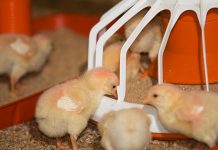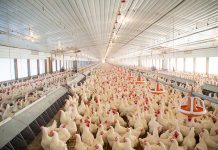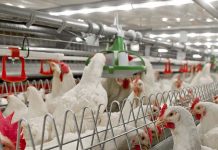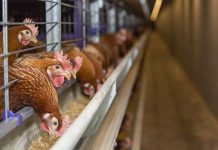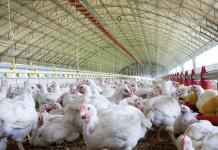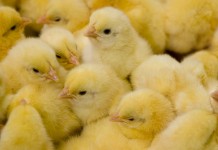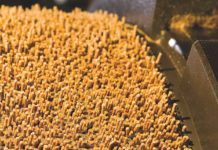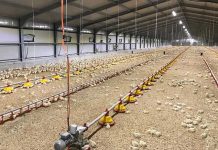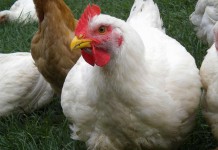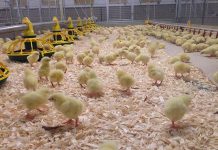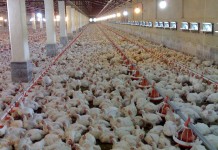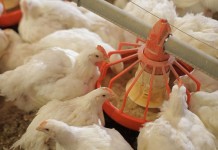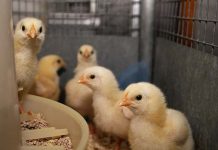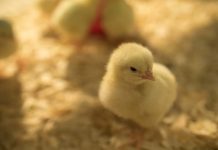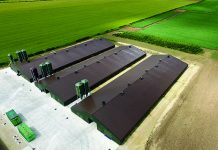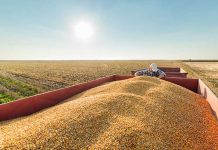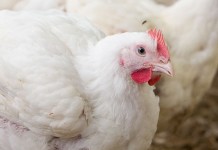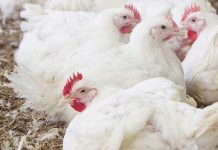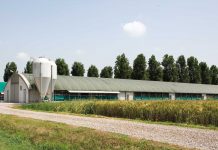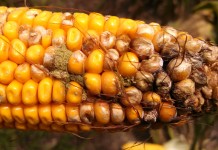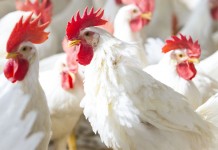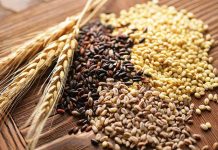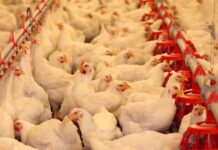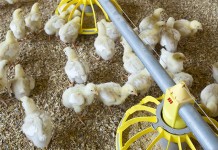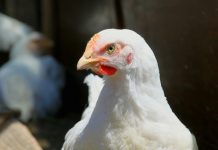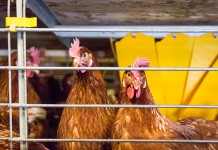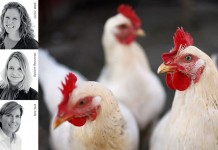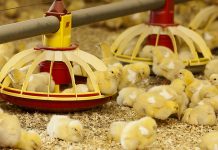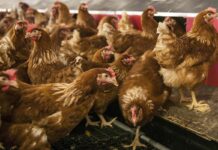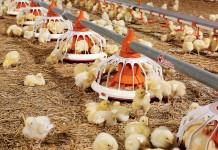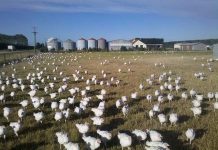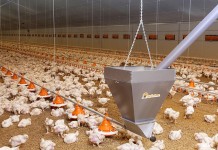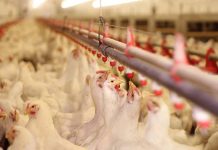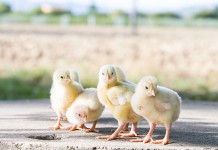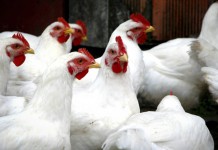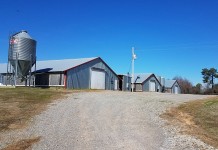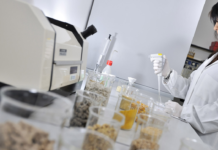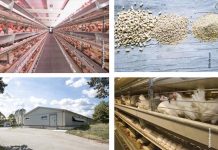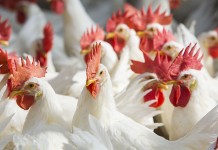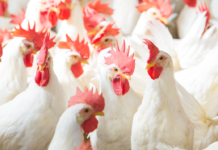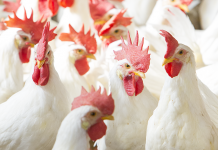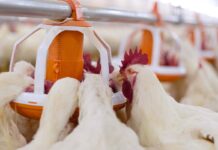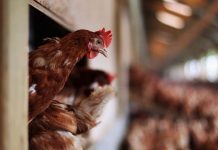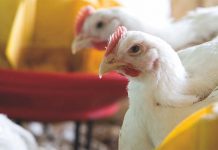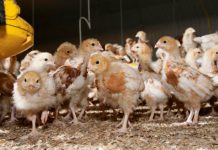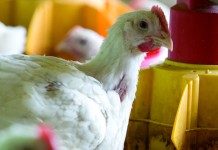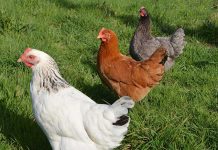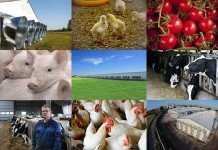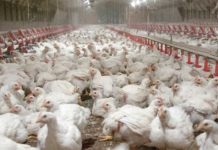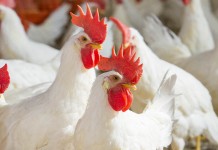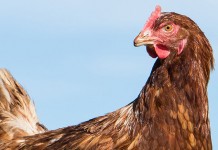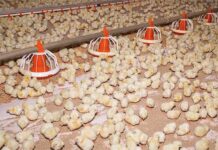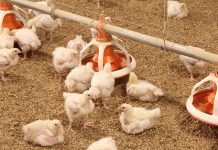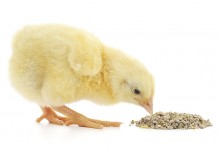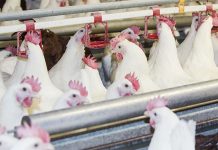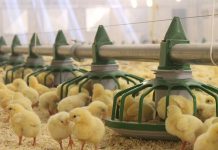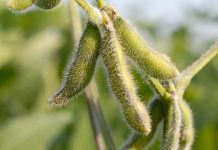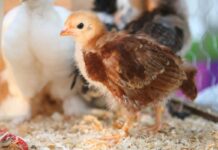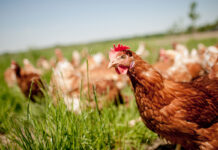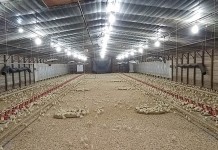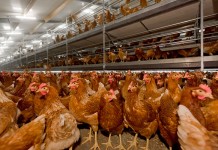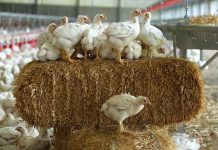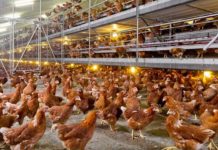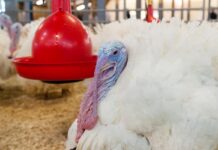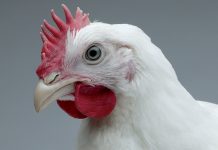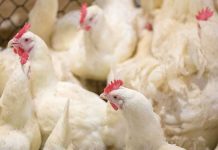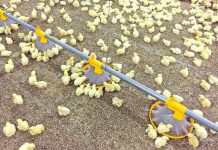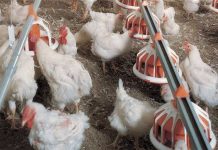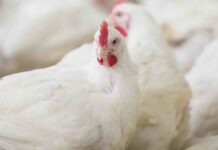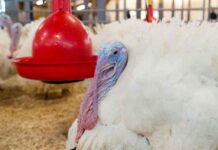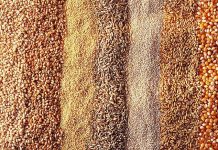Challenges in poultry feeding
Poultry producers around the world continue to struggle with high production costs for poultry feeding, largely due to volatility in prices for basic feed...
The challenge of feeding modern broiler breeders
Broiler breeders are expected to produce about 150 chicks in 40 weeks of production and even though it is commonly believed that selection for...
Precision feeding of broiler breeders
Precision livestock feeding relies on real-time sensor feedback from individual birds to decide whether or not to allocate feed, according to the needs of...
Vitamin D in laying hens: how high is high enough?
In 2010, the Institute of Medicine in the United States reviewed current literature and changed the estimated average requirement of 400 IU/day to a...
Effectiveness of a double choice test to assess dietary taste preferences in broiler chickens
Investigations into the taste system of chickens can help to improve poultry feeding strategies. However, a comprehensive study on dietary taste preferences for broilers...
The effects of in-ovo feeding
In-ovo feeding is a key issue in poultry. The embryonic and immediate post hatch developmental period represents a significant phase in attaining quality broiler...
Potential to produce poultry feed from food wastes
The annual food waste in Australia is estimated at 7.5 million tonnes
with the majority disposed of in landfills. This not only
causes significant economic loss...
Pellet quality and its effects on poultry performance
Pellet quality provided to meat birds throughout the industry is highly variable. Feeding birds pellets of poor quality can in part be attributed to...
Modification of the chicken intestinal epithelial physical barrier in poultry by dietary factors
The intestinal epithelial physical barrier is the most critical element of maintaining an intact intestinal barrier and made up of a layer of columnar...
Effects of dietary insoluble and soluble non-starch polysaccharides on performance and ileal and excreta...
This study examined the effect of dietary insoluble and soluble non-starch polysaccharides (NSP) in common broiler diets on performance and ileal and excreta moisture...
Feeding broilers of the future
The only way to maintain production is to improve the understanding of precision nutrition so that producers can feed broilers with low or no...
Measurement of energy utilization in chickens
Although corn prices have dropped from historic highs in the past years, energy continues to be one of the driving costs in poultry feeding....
Field experience on the use of probiotics in chickens and turkeys
Probiotics have been used for several years in an attempt to improve intestinal health. Recently, microbial products have been extensively studied as supportive treatments...
Crude soybean lecithin and vegetable acid oil as energy sources for broiler chickens
Lecithin and acid oil, as co-products from vegetable oil refining process, are economic alternatives to conventional fat sources and may represent an efficient energy...
A new perspective on feeding broiler breeders
Due to sophisticated genetic selection programs carried out by poultry breeding companies such as Aviagen, today’s broilers can grow with very efficient feed conversion...
The bioavailability of zinc in poultry: what does literature say?
Zinc bioavailability: zinc is an essential trace element for all the animals, including broilers. In case of deficiency, alteration of growth performance and distortion...
Corn milling efficiency and particle size effects on pullet growth performance
Corn is usually ground locally at the feed mill, while soybean meal is pre-processed and feed mills have little control over its particle size...
Short chain fatty acids and poultry gut health
Due to customer demands, producers have been asked to change the way they grow production animals, specifically through the removal of antibiotics. With this...
Probiotics as an alternative to antibiotics for treating lameness in broilers
The pathogenesis leading to a form of lameness known as bacterial chondronecrosis with osteomyelitis (BCO) appears to be initiated by mechanical microfracturing of susceptible...
Copper influences broilers’ performance and growth
Copper (Cu) is an essential component involved in a wide variety of biochemical processes. It must be supplemented in the trace mineral premix as...
Algae products in organic poultry diets
Algae, “the not so new kid on the block” has been used in both human and animal diets dating back centuries. There is a...
Feed borne mycotoxins: the threat to poultry?
Mycotoxins are metabolites produced by molds (fungi) that can infest crops pre-harvest and can continue to flourish under sub-optimal storage conditions. Grains with high...
Scientifically validated results to raise poultry production profitability
The Poultry Science Association 2017 Annual Meeting took place in Orlando, Florida on July 17-20. Being the most prestigious scientific event for poultry in...
Impact of grain type on performance in broilers under Necrotic Enteritis challenge
The aim of this study was to investigate the effect of grain type on performance and gut microbiota composition in broiler chickens under a...
The importance of feeding time observation
Achieving proper bodyweight, flock uniformity, and sexual maturity at light stimulation are some of the biggest management challenges for broiler breeder farms.
Today’s breeder pullets...
Influence of feed form and particle size on the performance and nutrient utilisation of...
The present experiment was designed to examine the influence of feed form and particle size in maize-based diets on the performance and nutrient utilisation...
Site and extent of digestion on poultry production
In poultry formulation and production of feed has evolved extensively in the last century with the identification of required nutrients, and subsequent and continuing...
Science unveils new pathway to broiler chicken growth performance
A new tool has emerged for broiler chicken operations seeking new ways to optimize results while keeping aligned with a full range of the...
Spirulina platensis Algae, a novel poultry feed additive
Identifying alternative replacements for soybean meal in a high quality and reasonable price is of importance in poultry production and physiological parameters. Spirulina platensis...
Challenges in longer laying cycle. Stabilizing egg quality
In the past 50 years, selection, initially at the breed level and then using quantitative genetics coupled with a sophisticated breeding pyramid, has resulted...
New applications such as superdosing of phytase to maximize phytate destruction to improve performance...
It is well documented that phytase supplementation in broiler diets improves P and Ca utilization through the destruction of phytate (IP6) and thereby allows...
A cost-effective poultry feed additives solution to partially replace vitamin E
Livestock producers typically use feed additives such as vitamin E to increase the antioxidant capacity of animals and minimise economic losses.
Recently, the price of...
Calcium nutrition, bone metabolism, and eggshell quality in longer-persisting layers
As regard layers management, rather than being depopulated at 60 to 70 weeks of age, or being moulted to allow for additional production cycles,...
Flexible Feed Formulation with GALLIPRO
Facing challenging goals
The goal of the poultry industry is to provide consumers with safe food, while promoting poultry health and welfare, in addition to carefully...
How to improve hen fertility
Following specific procedures to increase hen fertility will not eliminate drops in fertility, but it may also reduce the need to trouble-shoot breeder flocks.
Artificial...
Bacillus Subtilis improves performance of broilers fed medicated or non-medicated feed
Animal digestive health is key to obtain optimal performance. Antibiotic growth promoters (AGPs) have long been shown to be very effective to develop and...
Changing role of poultry nutritionist in a changing industry
Reflecting back on 30 years of working in the poultry industry as nutritionists we realize that the biggest changes that have occurred have mostly...
Early introduction of whole-grain diets to broiler chickens
The main problem with introducing whole-grain diets (WGD) to newly hatched chicks is the kernel size and this has led to such diets being...
On free amino acids – Their role in starch and protein digestive dynamics
The quantity of glucose and amino acids absorbed from the small intestine is a function of dietary concentrations, feed intakes and digestibility coefficients. Moreover,...
Using sunflower meal in broilers with the addition of a carbohydrase complex
Sunflower seeds are extensively grown for oil production for human consumption. Therefore, a great amount of sunflower meal becomes available for use in feed...
Fatty acids in ABF poultry production: a nutritionist’s perspective
The beneficial role of short-chain fatty acids and medium chain fatty acids on gut health and reducing pathogen colonization has been well documented over...
Keel bone integrity in layers – Observations, nutritional remedies, and myth-busting
The issue of keel bone deformities and abnormalities is different depending on various housing systems for the birds. Keel fractures have received a lot...
Evaluating phosphorous equivalency of phytases
The use of exogenous enzymes in non-ruminant nutrition is a valuable tool to increase digestibility and therefore spare the inclusion of expensive nutrients whilst...
Chelated copper compared to antibiotics effect on gut health in broilers
In this study the specific interventions of chelated copper methionine hydroxy analogue (cuMHAC) and a combination of cuMHAC and an effective foregut acidifier were...
High levels of cottonseed meal supplemented with composite microbial enzymes
Effects of cottonseed meal supplemented with composite microbial enzymes on broiler chickens.
Soybean meal (SBM) is the premier plant protein source used by the poultry...
Natural antioxidants in poultry production
From vitamins to vitagenes - First part
In general, there are four major types of stress in poultry production: technological, environmental, nutritional and internal stresses....
Path to the 100 week age layers in cage free systems
Egg producers are always looking for ways to improve layer hen’s efficiency as, nowadays, the genetic potential of layers is targeting an extended age...
Broiler breeders, a research on alternative feeding programs and photostimulation periods
USPOULTRY and the USPOULTRY Foundation announce the completion of a funded research project at the University of Georgia in Athens, Georgia, in which researchers...
Effect of two different fibre sources on growth and immune function in grower layer-pullets
This study was conducted to evaluate the effect of two different fibre sources on pullet growth, gut immune tissue, and lymphocyte proliferation of strain...
Phosphorus: how low can we go in broiler diets?
Phosphorus (P) is essential for all forms of life. Dietary P content either in excess of, or below requirements may adversely affect broiler performance....
Comparison of the effects of dietary available phosphorus and feed restriction on performance, egg...
This study was performed to evaluate the effect of available phosphorus and restricted feeding level on laying hens productivity, egg quality and yolk fatty...
Feed Conversion Ratio optimized for farmer profit
The farmers’ cost for animal feed is one of the main expenditures consisting of 60-70% of the overall producer costs. These producer costs are...
Ideal amino acids and chicken gut disturbance
There is considerable interest in the development of low protein diets
with supplemental amino acids for broiler chickens due to economic, environmental and bird
welfare advantages....
Black soldier fly larvae in meat chicken diets modifies the fatty acid profile in...
Black soldier fly (BSF) larvae are a promising alternative feed ingredient for monogastrics,includingpoultry.However,theimpactoffeedingBSFlarvaeinbroilerdietson the fatty acid profile of the breast chicken meat remains unknown.
This...
Feather-eating hens show specific essential amino acid appetites in a double-choice model
Nutritional balance is one of the major considerations to prevent severe feather pecking in layer hens. Individual variation in digestive and metabolic efficiencies and...
Broilers diets with high and low net energy but similar metabolisable energy
A semi-commercial scale feeding study was conducted to compare formulations of broiler diets based on predicted net energy (NE) and metabolisable energy (ME). It...
Corn co-products in broilers
The expansion of the ethanol industry has increased the availability of a variety of corn co-products as feedstuffs for livestock and poultry. Of the...
How Xylanase can improve performance of a broiler diet
Whilst xylanase rich NSP-enzymes are used consistently in wheat based diets the question remains whether the positive response seen can be ascribed solely to...
Antioxidants in broiler breeder diets can affect offspring performance
In a series of experiments, it was shown that antioxidants in broiler breeder diets can affect broiler performance trans-generationally. To study this, a polyphenol...
Lowering dietary calcium and available phosphorus in broilers
The aim of this trial was to investigate the effect of lowering dietary calcium (Ca) and available phosphorus (av.P) during Starter (0 to 10d),...
NIRS study on nutritional profiles of 100 soybean meal samples from USA and Brazil
This paper compares the nutrient profile of soybean meal (SBM) samples from the USA and Brazil. Proximate analysis, total amino acids, standardized ileal digestibility...
Layer nutrition associated with different production systems
The egg industry continues to grow; in the past this was in cage production, but today’s growth is focused on alternative production systems such...
Organic acids as feed additives: pros and cons
Organic acid salts are often included as feed additives in livestock nutrition as feed preservatives but also as growth promoters, intestinal microbiota enhancers, and...
Measurement of true ileal calcium digestibility of meat and bone meal for broiler chickens
Currently, there is a move towards the use of digestible phosphorus (P) in diet formulations for poultry due to P excretion into the environment...
Dietary non-phytate phosphorus levels for laying hens in the last phase of lay
The phosphorus (P) requirement of laying hens is an area of on-going debate and it is a factor that contributes to hen performance and...
Effects of low protein and balanced amino acid levels on birds under subclinic NE
One benefit of low protein (LP) diets is improving gut health in a future of antibiotic-growth promoter free diets.
Drew et al., (2004) found an...
Lactobacillus acidophilus D2/CSL (CECT4529): 35 years of Italian research (1985-2020)
The history of the probiotic strain Lactobacillus acidophilus D2/CSL (CECT 4529) follows that of many strains produced by Centro Sperimentale del Latte and acts...
The potential of perinatal nutrition
Based on Darwin’s theory of adaptive evolution and Mendel’s fundamental laws of heritability, breeding and genetic selection for increased growth rate and meat yield...
Benefits of non-synthetic, natural oregano essential oil in pullet rearing
Feeding oregano essential oil to pullets during rearing can help to improve flock uniformity, reproductive fitness and feed efficiency, according to research undertaken at...
A dose response of a heat stable phytase on broiler performance and nutrient digestibility
Phytases have been heavily researched for decades and been used commercially since the early 1990s. Phytase from microbial origin is therefore added to monogastric...
Water quality guidelines for turkeys
Turkeys typically consume twice as much water as feed, so it is important to provide a clean, healthy water supply. Water not only serves...
Ileal amino acids digestibility in response to increasing phytase dose or MCP levels in...
Commercial broiler feed is formulated mainly with plant based ingredients including cereals and oil seeds. These ingredients provide low available P because 70-80% of...
Low protein diets supplemented with glycine, glutamine or arginine for broilers
A previous study highlighted differences between a low protein (LP) diet and a higher concentration of amino acids (AA) for intestinal permeability and performance...
Low protein diets in broilers
Some recent research at the Arkansas Agriculture Experiment Station Poultry Research Farm has been focused on low protein diets in broilers. Many nutritionists rely...
Research examines alternative feeding programs and photostimulation periods for broiler breeders
USPOULTRY and the USPOULTRY Foundation announce the completion of a funded research project at the University of Georgia in Athens, Georgia, in which researchers...
Reducing undigested protein available at the intestinal wall on broilers
An experiment was conducted to evaluate the effects of supplementing an inherently thermo stable protease in broilers fed diets based on single raw materials,...
Effects of beta glucans in poultry health and nutrition
Immune modulators such as beta glucans have today a major role in poultry production.
The poultry production industry has seen astonishing improvements over the past...
EU Compound feed production in 2021 – Market Outlook 2022
Industrial compound feed production in the EU remained stable in 2021. Looking forward, the spread of animal diseases and the continuing global grain market...
Feed physical quality
The effect of feed form is well established, however, feed physical quality is often seen as an issue in the field (see Figure 1)....
Can xylanase inhibitors affect the efficacy of xylanases in poultry diets?
Xylanase inhibitors are reported to be widely present in cereals, and can influence the assay of supplemental xylanases in feeds.
In the present study, a...


